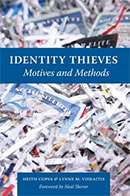Identity Thieves: Motives and Methods

Authors: Heith Copes and Lynne M. Vieraitis
Boston: Northeastern University Press, 2012. 174p.
Reviewer: Cory Schnell | September 2012
The online retailer Amazon.com has over four thousand books available on the topic of identity theft. One of the first books a search of this website will reveal is from the popular For Dummies series. The book is fittingly titled Identity Theft for Dummies. Outside of this book’s ambiguous and perversely comical title the mere existence of this book can signify the level at which identify theft has become instilled into mainstream American culture. This is undoubtedly a flawed metric, but coupled with the fact that over four thousand books on the topic exist, it begins to demonstrate the level of attention paid to the crime. Identity Thieves authors Heith Copes and Lynne Vieraitis are undoubtedly aware of this and craft a limited, yet revealing look at how identity thieves think and operate.
Copes and Vieraitis are open about the limitations of their work. They explicitly discuss the conundrum that is posed in analyzing their data. On one hand they are painfully aware of the weaknesses of their study. The authors sample was created by systematically searching media and legal records of people who had been federally convicted of identity theft. From this sample the authors conducted in-depth interviews with fifty-nine inmates in fourteen different correctional facilities across the United States. Notwithstanding any problems with this sampling strategy, it is still not ideal to make generalizations on a large offending population from only fifty-nine interviews. On the other hand, though Copes and Vieraitis argue that since there are no foundational offender based studies on identity theft to build upon, this work has to lay a blueprint for how to collect, analyze, and generalize data about identity thieves.
Methods and motives for the offenders were relatively uniform across the sample. Copes and Vieraitis found that identity thieves worked in one of three capacities: alone, in street-level identity theft (SLIT) rings, or in occupational teams. What is more surprising is that each of the three groups used primarily low-tech methods to commit the offenses. Having workers steal vital information from their employers in addition to digging through trash cans and pilfering mailboxes was more common than any digitally based technique. In addition, Copes and Vieraitis found that identity thieves are practically carbon copies of street offenders when it comes to motives. They commit crime for money, power, and for the thrill of the act. Also, they use similar strategies as street offenders to justify the crime to themselves. In reality it is easier for identity thieves to deny injury and to deny a victim due to the remote nature of the offense.
Two peripheral contributors to the book, Neal Shover and Richard Wright, do a superb job of situating the book in the larger context of criminology. Shover, who writes the book’s foreword, and Wright, in a blurb, argue that identity theft is one of many “new” crimes worth studying for criminologists. On the most basic level these crimes are worth studying because of the paucity of quality research on the subjects. In a more complex formulation they could represent macro-level shifts in offending patterns. Wright briefly states that “the so called Great American Crime Drop that began in the mid-1990’s might more accurately be described as the great American Crime Shift. Even as street crime plummeted, other forms of criminality increased, including identity theft.” Copes and Vieraitisdo not explicitly attempt to address this question nor do they have to. Identity Thieves wisely does not bring up questions it cannot answer, and thus remains grounded in the truest sense. That is above all other reasons why the book is a major success.
Cory Schnell is a Ph.D. student at Rutgers School of Criminal Justice.


